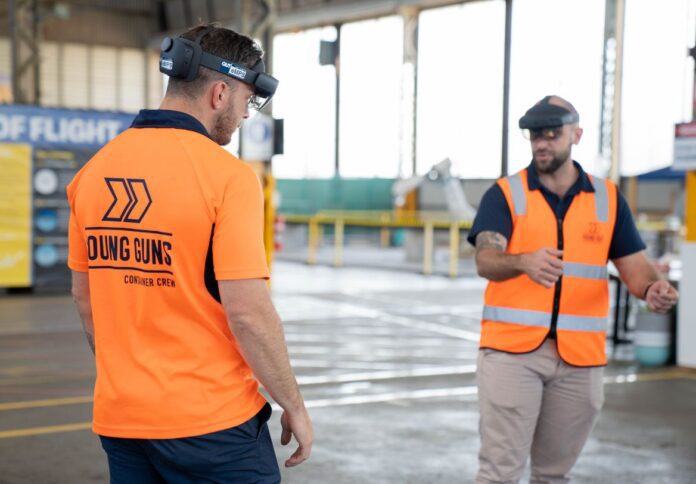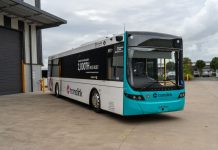
Media Release by ARM Hub
A family-owned Queensland business specialising in the packing and unpacking of shipping containers is developing an AI-enabled automated packing solution that could increase their productivity by up to 50 per cent.
“Young Guns worked with ARM Hub to look at ways we could reduce the downtime of pallet stackers and forklift drivers so we can unload containers more quickly and improve the service offering to our clients,” said Scott Young, co-founder and Director of Young Guns Container Crew (YGCC).
“There is a significant drive from leading retailers internationally to innovate within their supply chain transformation strategies – predictability, visibility, and productivity will be a key component in these transformations, and we believe our shipping container innovation will create opportunities for this to occur at the container face that are not currently availability in the industry.”
YGCC is an indigenous business founded in 2004 by Brisbane brothers, Scott and Trent Young, that cultivates a highly skilled workforce and focus on innovation.
ARM Hub CEO Associate Professor Cori Stewart said the Polaris design solution developed by the Young Guns team, translated to a process efficiency, as measured in person-hours to load a container, of between 25 and 50 per cent.
“And that is not factoring in the value of additional data that can be captured by Polaris; things like how many pallets have been packed, the rate at which pallets are stacked and whether they are in the right order and have barcodes,” Dr Stewart said.
“This type of data is of enormous interest not only to Young Guns but also to their clients.”
For the past 12 months, a YGCC team have been working with ARM Hub and QUT School of Design to investigate automation of the container destuffing process to improve safety, productivity, and efficiency in the supply chain.
ARM Hub’s lead engineer Tim Kelly said the primary issue with fully automating the de-stuffing of containers using computer vision and robot arms was dealing with sorting and handling the unknown arrangement of cartons in each container.
“Initially the project was about looking for any existing automated solutions for de-stuffing containers which is a difficult process to automate,” Mr Kelly said.
“It’s not an orderly environment – there is no control over the arrangement of the container as it comes in. We’re dealing with loose-packed containers with lots of different-sized objects, and a lot of stock collapses.
“But you can get significant person-hours gains through targeted high-value automation and camera vision, which frees workers to focus on the more chaotic environment.”
Product Design Challenge
Phase One of this project, now known as Polaris, consisted of two collaborative Design Thinking ‘double-diamond’ workshops where the first diamond defines the problem, and the second diamond solves the problem.
These workshops comprised staff from YGCC, ARM Hub and QUT, and was led by Associate Professor Jared Donovan, Associate Professor in Interaction Design in the QUT Design Lab, and Dr Tim Williams, Senior Lecturer in Industrial Design at QUT.
In Workshop 1 – Discovery, various design methods were used to comprehend the intricacies involved in current workflows and narrow down key criteria and guidelines for conceptual design direction.
In Workshop 2 – Define, three concepts were proposed and evaluated by the team, with aspects from all three funnelled into one holistic design direction.
Phase Two of Polaris, led by ARM Hub’s Tim Kelly entailed taking the learnings from Phase One and building them out into a more well-defined concept that has a high probability of successful commercialisation.
Mr Kelly said the team workshopped the concepts that were already developed, and work that Young Guns had already done independently on a ‘safety cage’ device.
“And we kind of brought all those together. We created a set of design requirements and we came up with this concept, which we’ve shown through simulation will reduce the amount of labour in the process by 25 to 50%, which in a logistics environment is a huge saving.”
The project team decided to develop the ‘Polaris cartridge’ design, which allows a forklift to supply up to two empty pallets at a time, integrated rollers, a wrapping station, and an integrated blocker device.
Mr Kelly said there is a high probability that Polaris will provide a significant and lasting competitive advantage for YGCC through the use of difficult-to-replicate technology and IP.
Simulation
The team mocked up their distribution centre, containers, and the Polaris product in a 3D CAD (computer-aided design) model, and transitioned the data into an augmented reality environment in HoloLens.
The simulation used in the development of Polaris tracks the actions and interaction of each aspect of container de-stuffing.
Each unpacker, forklift, container, and pallet are represented as an agent within a distribution centre.
“We showed what the product would look like at various stages of utilisation in the distribution centre,” Mr Kelly said.
“We had YGCC’s frontline team come in and they could put the headsets on, and they could walk around in the virtual future distribution centre environment with two people at a time.
“They could discuss what it would be like to use the device in different stages and get a feel for it and what it’s trying to do. That was hugely beneficial for them in terms of being able to engage with what the device is, because they didn’t just have to imagine being with it, they could actually be with it.”
Each simulation can be tuned – the number of workers, containers, containers to be unpacked in parallel, forklifts available, pallets per container, carton mix per container, and the recommended number of staff to unpack each container.
YGCC believe a simulation tool will help them to generate more accurate costings for quoting purposes. They also see value in it for daily operational planning purposes, to optimise staff utilisation across each distribution centre.
Process maps were developed of three real-life Distribution Centres serviced by YGCC that run different infrastructure and processes.
From this baseline, a comparative analysis of the Polaris device versus the existing processes was used to determine the improvements in operating efficiency across the distribution centres, including:
- The % of value-added vs waste time
- The change in total time to unload a container
- The change in man hours to unload a container
Benefits
The Polaris design enables previously sequential processes to run in parallel; fully automates the wrapping process; minimises movement waste, and waiting waste is minimised.
“Waste time in the form of movement and waiting can be reduced from 25 down to 5 per cent,” Mr Kelly said.
“Allocating the correct number of workers per stock type is important in achieving these improvements.”
The fewer workers that are used to stack, the more efficient Polaris becomes, as the speed of the forklift can bottleneck the process for some stock mixes.
Mr Kelly said there are several improvements to the simulation that can be built into the next version to make it even more powerful for the YGCC team.
“Using this simulation as a foundation, we’d like to develop a simulation tool that YGCC can use for improved quoting and costing purposes, as well as for daily operational planning.”
Phase Three of the project involves building a prototype of Polaris at ARM Hub’s Learning Factory.


















